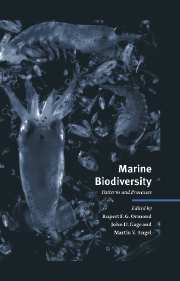Book contents
- Frontmatter
- Contents
- List of contributors
- Foreword: The value of diversity
- 1 Marine biodiversity in its global context
- 2 Gradients in marine biodiversity
- 3 Pelagic biodiversity
- 4 Biological diversity in oceanic macrozooplankton: More than counting species
- 5 Large-scale patterns of species diversity in the deep-sea benthos
- 6 Diversity, latitude and time: Patterns in the shallow sea
- 7 High benthic species diversity in deep-sea sediments: The importance of hydrodynamics
- 8 Diversity and structure of tropical Indo-Pacific benthic communities: Relation to regimes of nutrient input
- 9 Why are coral reef communities so diverse?
- 10 The biodiversity of coral reef fishes
- 11 The historical component of marine taxonomic diversity gradients
- 12 Population genetics and demography of marine species
- 13 Discovering unrecognised diversity among marine molluscs
- 14 Ecosystem function at low biodiversity – the Baltic example
- 15 Land–seascape diversity of the USA East Coast coastal zone with particular reference to estuaries
- 16 The development of mariculture and its implications for biodiversity
- 17 Protecting marine biodiversity and integrated coastal zone management
- 18 Conserving biodiversity in North-East Atlantic marine ecosystems
- Author index
- Species index
- Subject index
5 - Large-scale patterns of species diversity in the deep-sea benthos
Published online by Cambridge University Press: 04 August 2010
- Frontmatter
- Contents
- List of contributors
- Foreword: The value of diversity
- 1 Marine biodiversity in its global context
- 2 Gradients in marine biodiversity
- 3 Pelagic biodiversity
- 4 Biological diversity in oceanic macrozooplankton: More than counting species
- 5 Large-scale patterns of species diversity in the deep-sea benthos
- 6 Diversity, latitude and time: Patterns in the shallow sea
- 7 High benthic species diversity in deep-sea sediments: The importance of hydrodynamics
- 8 Diversity and structure of tropical Indo-Pacific benthic communities: Relation to regimes of nutrient input
- 9 Why are coral reef communities so diverse?
- 10 The biodiversity of coral reef fishes
- 11 The historical component of marine taxonomic diversity gradients
- 12 Population genetics and demography of marine species
- 13 Discovering unrecognised diversity among marine molluscs
- 14 Ecosystem function at low biodiversity – the Baltic example
- 15 Land–seascape diversity of the USA East Coast coastal zone with particular reference to estuaries
- 16 The development of mariculture and its implications for biodiversity
- 17 Protecting marine biodiversity and integrated coastal zone management
- 18 Conserving biodiversity in North-East Atlantic marine ecosystems
- Author index
- Species index
- Subject index
Summary
Abstract
As in other environments, species diversity in the deep sea reflects an integration of ecological and evolutionary processes operating at different spatial and temporal scales. Contemporary deep-sea research has focused primarily on the importance of small-scale phenomena that permit species coexistence. While this work has provided important insights into the mechanisms that regulate local diversity, it is unclear how small-scale events can account for geographic patterns of diversity. A complete understanding of diversity must incorporate the influence of historical, biogeographic and oceanographic processes that are imposed at much larger scales. In this chapter, we review large-scale bathymetric and geographic patterns of species diversity in the deep-sea benthos and discuss how ecological and evolutionary factors might shape these patterns.
In the western North Atlantic, the most thoroughly sampled region of the World Ocean, species diversity is low on the shelf, increases to a maximum at intermediate depths and then decreases in the abyssal plain. Analyses of diversity in other deep basins of the Atlantic indicate that this parabolic trend may not be universal, but good comparative data are extremely limited. The marked variation in diversity at any particular depth indicates that extensive sampling is necessary to accurately assess bathymetric patterns. The causes of these patterns are not well understood, but appear to involve environmental gradients in nutrient flux, biotic interactions and environmental heterogeneity.
- Type
- Chapter
- Information
- Marine BiodiversityPatterns and Processes, pp. 94 - 121Publisher: Cambridge University PressPrint publication year: 1997
- 59
- Cited by



